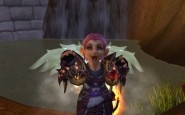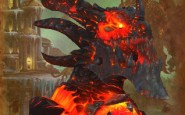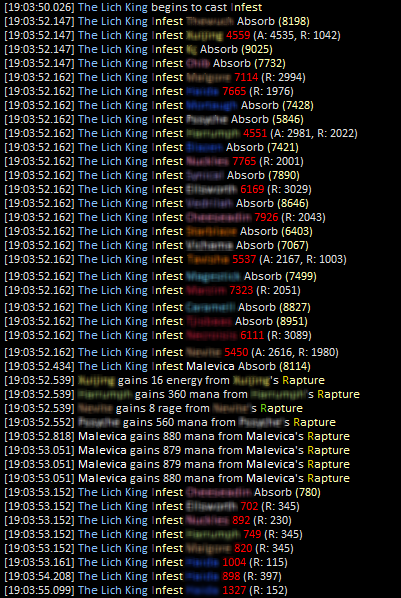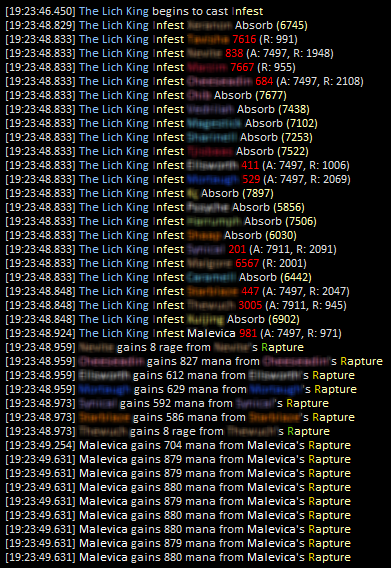
Welcome to the new, improved, hopefully still functional Type “H” for Heals!
This is just a quick post to confirm you are indeed reading the right blog and subscribed to the right feed, so congratulations, and thanks again for reading.
Because I’ve redirected the old url to this one you will not need to update bookmarks, but you will need to update your RSS feed subscription if you use that.
The new urls are http://typehforheals.com for the home page, and http://typehforheals.com/feed for the RSS feed.
Pewter unknowingly spurred me on when I saw the new guild site she’s been working on (it looks awesome, by the way!).
Thanks for reading, and for bearing with me during the transition.
Possibly Related Posts:

For the last couple of weeks my guild has been working on Heroic Professor Putricide, and I thought I would share some of the lessons we’ve learned over the nights.
I’ll assume that you’ve seen the normal mode of this fight, so if you haven’t then the mechanics might be unfamiliar.
Phase 1
The big differences between normal and heroic here is that the Volatile Ooze (green) and Gas Cloud (orange/brown) hurt more and move faster, and the addition of the Unbound Plague.
The Ooze and Cloud are easy enough to deal with, you just pull out the strategy you used initially, and possibly stopped bothering with once the buffs began ratcheting up:
- When the green Volatile Ooze is spawning, we have all the melee DPS gather next to its spawn point, aiming to be knocked back to the table (all in the same direction is important, and towards the table is a good habit for transitions), and the ranged and healers all stand well away so the Ooze has a long way to run. The biggest problem people are those who don’t get in quickly enough and are therefore not knocked back. If you don’t think you’re going to make it, back out again rather than standing at 10 yards, your raid will thank you.
- When the Gas Cloud is spawning, everyone should stay at range until it has got a target. If it’s not killed in time and is going to pick a different target, everyone should run away from it. A melee getting hit by it immediately has a fair chance of killing raiders, and is not recommended.
If you get your positioning sorted out, and people are quick on their feet, these shouldn’t pose many problems.
As a bonus tip, having a Holy Priest specced for Body and Soul is not essential but extremely handy to save a Gas Cloud target who finds themselves trapped or unable to escape.
From a healing perspective, the melee will be taking the brunt of the damage in this phase, along with the tank who will be taking 30-40k blows from the Professor. An Ooze exploding on a typical melee complement will be landing for around half their health each, a bit more if people are slow. This is not hugely dangerous unless they get an unfortunate hit again shortly afterwards, in which case you need to have words about positioning.
It should also be noted that the person with Volatile Ooze Adhesive or Gas Bloat will be taking 10-14k ticks, so they do need some focused healing.
The fight as a whole is extremely mobile, so healers can help themselves by assigning people to sectors of the room. You will need to move throughout the fight, but having somewhere to gravitate back to helps to ensure that everyone is in range of someone.
The extra wrinkle in Heroic mode, which begins in Phase 1 and continues to the end of the fight, is the Unbound Plague. This is an undispellable debuff placed on a random player every 60 seconds (although he seems to delay casting in at the start of each phase). The plague has a 60 second duration, but the damage done increases with every 1s tick, as illustrated in the table below, until it gets passed on to another person by running into them. That person keeps the duration the plague had when it was passed, but the damage starts low again.
(Edit: I’ve corrected an anomaly in the table at stack 14, which was due to an absorb being credited fully and artificially raising the number to 17338).
| Tick | Damage | Increase |
|---|---|---|
| 1 | 932 | – |
| 2 | 1164 | 1.25 |
| 3 | 1455 | 1.25 |
| 4 | 1819 | 1.25 |
| 5 | 2273 | 1.25 |
| 6 | 2842 | 1.25 |
| 7 | 3552 | 1.25 |
| 8 | 4441 | 1.25 |
| 9 | 5551 | 1.25 |
| 10 | 6938 | 1.25 |
| 11 | 8673 | 1.25 |
| 12 | 10840 | 1.25 |
| 13 | 13551 | 1.25 |
| 14 | 16938 | 1.25 |
| 15 | 21173 | 1.25 |
| 16 | 26466 | 1.25 |
| 17 | 33083 | 1.25 |
| 18 | 41354 | 1.25 |
The upshot of all this is that the plague needs to be passed off at around the 10-11 second mark. It’s theoretically possible to hold it for longer, but with latency, the risk of an extra tick, people running out of range, and all manner of other unforeseen problems, it’s best to err on the side of caution.
Vent/TS help a lot with this. When you get the plague, look around you for someone to pass it on to. Avoid people who’ve already had the plague, identified by a green haze around them (or the Plague Sickness debuff on Vuhdo/Grid), because Plague Sickness increases the damage the plague does to you by 250% per stack, and you gain a stack when the plague leaves you (60s duration). Once you’ve identified your target, tell them on Vent or whisper them (%t macros can be handy, think back to Lady Vashj), so they know not to run off at the wrong moment. We found it somewhat helpful to make /say macros with something like “I’m free” or “WTB plague” to let people nearby know you’re available to pass plague to.
Healers need to remember that the person with plague will need dedicated healing, preferably from more than one person, and that if a healer gets it they will not be able to heal themselves as effectively if they’re moving to pass it on, so be sure to cover for your fellow healers!
A refinement you can use is to look at the duration of the plague. If it has 10 or fewer seconds left you can keep it until it fades. This minimises the number of passes, and thus keeps more people without Plague Sickness. It helps if you announce your intention to keep it, so healers can keep a close eye on you and people know not to try and take the plague off you.
Finally on this phase, what to do if the plague gets into the melee? Well, the simplest thing to do is to just let it bounce around. It only does damage when it ticks, and it’s often passed on before it can tick. But this can’t carry on forever, because with high stacks a slow pass could mean a one-shot for your melee, so you do need to pass this off eventually.
The easiest way to pass it off is when the Volatile Ooze is exploding and the melee get knocked out to range. If you have the plague when you get knocked back, just pass it to a nearby ranged player. But please, make sure you actually have got rid of it before running back in.
If this isn’t convenient, have your spare tank(s) stand slightly further out from the melee group. When they get the plague they can quickly step away from the melee cluster and out of passing range, and then hand it off to a ranged player. Warriors with Intervene work well for this role.
Transition
Timing of the transitions is a huge deal in Heroic mode. Because Putricide will spawn 2 additional adds in this phase, one Volatile Ooze and one Gas Cloud, having another add up at the same time will probably lead to a wipe because they can’t all be slowed. Stop DPS fully at 82% (DoTs will tick him down to 81%), and be sure to burn him under once the previous add is dead, before he can spawn another one.
Where in Normal mode Putricide would stun the raid with Tear Gas, in Heroic he runs to the table and spawns a Volatile Ooze and a Gas Cloud simultaneously from their usual positions. What’s more, half of the raid will gain Ooze Variable, making them only able to attack (and according to the tooltip, only able to be targeted by) the Volatile Ooze, and the other half will gain Gas Variable, making them only able to attack (and be targeted by) the Gas Cloud.
Positioning is everything here.
Everyone with the Ooze Variable should gather up under the Volatile Ooze, standing on the table side of it so they will all be knocked in the same direction. Everyone with the Gas Variable should run away from the Gas Cloud’s spawn point, and stay away from the Ooze spawn point as well since sometimes they seem to target the “wrong” people.
The reason for this grouping is that you maximise your chances of having enough people gathered on the Ooze when it explodes, and you can DPS it while it is spawning and acquiring a target.
Bear in mind that the Variable debuffs seem to be random, so you can get more healers in one team compared to another. Healers can and should do some DPS here, as getting the adds down quickly is extremely important.
The Abomination should be able to apply three slows in this phase, one to the Ooze and two to the Gas Cloud is recommended. To do this the Abomination needs to leave a pool or two intact in order to suck them dry during the transition. They do not grow while the Professor is at his table, so this cannot be relied on for energy generation.
Phase 2
A bit of an anticlimax after the fun of Phase 1, there’s not much different here. The Unbound Plague continues (after a delay at the start before the first plague is introduced), the Ooze/Gas still spawn, and the Malleable Goo works the same as it does in Normal mode.
The only real difference is that there are three Malleable Goos on Heroic, rather than two on Normal. This makes it a bit trickier to avoid them, especially if several are launched in roughly the same direction, but if you’re attempting Heroic Putricide you should be able to cope.
Don’t worry though, things get more exciting at 35% when Phase 3 starts, initially with a transition like the one at 80%. Stop DPS at 37%, kill off the previous add and then burn him down to under 35% quickly.
Phase 3
Unlike the Phase 1 – Phase 2 transition, I’ve not given this a separate section. This is because it helps to think of Phase 3 as one long DPS burn phase, rather than a transition followed by a burn.
At 35% Putricide again runs to the table and again spawns one of each type of add, which should be handled as you did for the Phase 1/2 transition. Once he’s finished at the table he will become active and begin stacking Mutated Plague on his current tank every 10 seconds or so (later if he’s casting at the time).
Just like Normal mode the Malleable Goo and Choking Gas Bombs will continue, and the slime puddles will continue to grow, blocking your path. This burn phase will last longer on Heroic though, so you need to be more careful where you place the slime puddles. Being ahead of the boss is a big no-no. Also, because DPS is so crucial, it is vital for ranged and healers to stay at range so that you always have 8 or more, meaning Malleable Goo won’t target melee. If this happens the DPS loss is crippling.
The big damage source is the Mutated Plague mentioned earlier. This is applied to Putricide’s current tank every 10s, roughly, and deals raid-wide shadow damage dependent on the number of stacks, increasing faster than linearly with stacks so a 2-stack does more than twice the damage of a 1-stack.
To keep stacks as low as possible, tanks will be rotating every one or two stacks. We use a rotation which means our tanks get to 2 stacks initially, then take one more at a time after that, i.e. 1-2-1-2-1-2-1-2-3-3-3-3-4-4-4-4. The discussion that follows will assume this rotation, so if you use something different you may need to readjust the figures.
For healers, it’s vitally important to understand the damage profile here. Just watching the healthbars last night, once we got a couple of tanks on 3 stacks the bars just start to plummet and very quickly we were down half a raid.
I went through the logs and plotted out the damage profile, because it’s useful to see this. For reference, we’re wiping at around 90-100s, when 3 tanks have got 3 stacks on them. Times are from the first stack application on the first tank, which is pretty much immediately once he mutates. We use a 4-tank strategy. The 3-tank approach is frankly terrifying!
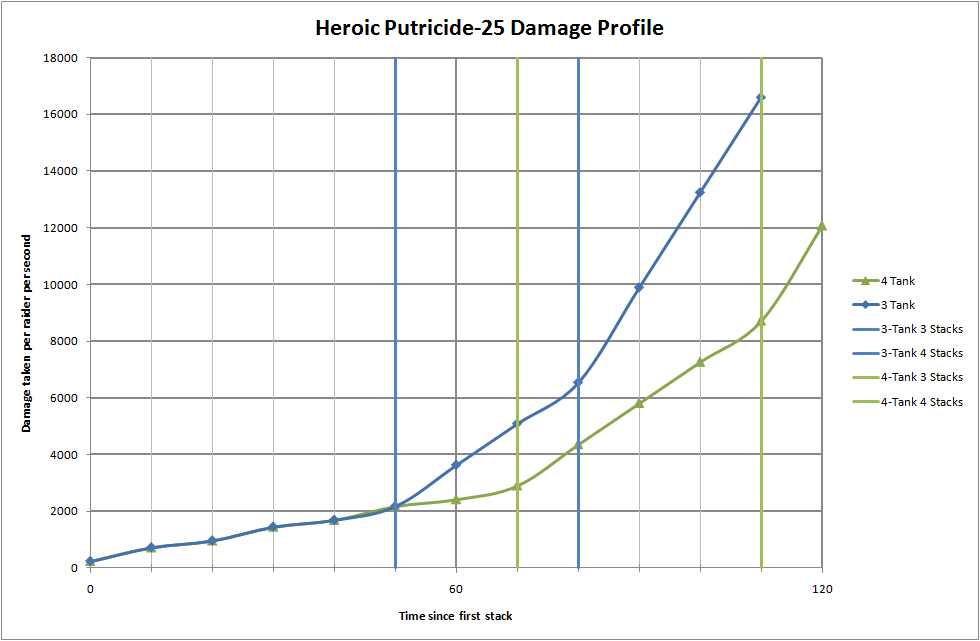
An illustration of the damage taken per player per second due to the Mutated Plague. This chart compares a 3-tank an 4-tank strategy.
At the point we’re wiping, each raider is taking an average of 6-7k damage per second (the ticks are every 3s, so there’s 4 ticks spread over a 3s window), so without heals we’re talking about 4-5 seconds time to live. At 70s (when the last of the 2-stacks is going on, before we hit the 3-stack regime) the TTL is over 10s. I’m assuming 30kHP, since that’s basically what I have in a raid, and I’m important!
Those numbers are pretty scary, especially when expressed in TTL terms, and when you look at how quickly the raid damage ramps up. The proportion of damage shifts dramatically towards the raid in the end of Phase 3, so healers need to be prepared, and assigned, to break off the tanks and start healing the raid. You’re only needing to buy maybe 10-15 seconds, but that’s crucial.
Healers need to be fully aware of the stacks on the tanks in order to know when to switch from tank-healing to raid-healing. Tanks can help out by saving their shiniest (damage-reducing) cooldowns for that point. Bonus healing isn’t as useful as a damage reduction when healing’s at a premium.
Things like Divine Sacrifice are amazing, but need to be saved for a very late in the fight. They’re needed when the 3-stacks start to go down (Paladins can use their judgement (see what I did there?) about the exact timing) to flatten the curve and buy a few more seconds. Your Paladins might be using them to save people from Goo, but people really need to be dodging that, not using cooldowns for it.
Also remember that Mutated Plague is shadow, so an Aura Mastery on Shadow Resistance Aura could be awesome too.
Saving this for last, because it’s often out of the healers’ control, but the best way of getting round the problem of wiping late in Phase 3 is simply to get it over quicker. Do it in 80 seconds and life’s easy; need 100 seconds and it’s a real struggle. The gradient of that curve turns into a pretty hard Enrage once there are 2-3 3-stacks active. Actually it’s easily arguable that dropping a healer might be a good way to go: it sounds counter-intuitive, but killing him in 90s compared to 100s lightens the healing demand by a full 20%, and might be enough.
One huge tip is to try blowing Bloodlust as soon as the adds are active in the transition, once debuffs are up. Here’s the logic:
Looking at Phase 3 as a single burn of adds plus boss, the logical thing is to use Bloodlust where you can do the most effective damage. In the transition, there are dangerous Oozes and Gas Clouds active which would be much better dead, and if they die early then you get uninterrupted, movement-free DPS time on the boss while he’s still at his table and in his initial tanking position before he throws out the Goo, or drops the bombs, or the slime puddles have grown too much, etc.
And healers can also help out with the DPS, especially early in the phase when healing’s light, by adding DPS. Pop Shadowfiends and Fire Elementals, lay DoTs or other damaging spells down when you have spare GCDs, it all helps.
Good luck!
Possibly Related Posts:

I came across the line in the title while dipping into the EJ WotLK Priest Healing Compendium recently, and it made me think about how we tend to try and pigeon-hole healers.
Why do we label healers?
Humans are fundamentally pattern-seeking creatures: it is our natural tendency to try and classify the world, to relate it to things we have experience of, and to reduce it to a set of simpler rules.
In WoW, when a raid leader is faced with 5-7 healers to assign, of up to five different specs, all with unique personalities and skills, their natural reaction is to fall back on these heuristics in an attempt to reach as nearly-optimal a solution as possible.
Because the assignment is based on these heuristics, the quality of the classification scheme will directly influence the quality of the resulting assignment.
Common classification schemes
I’m going to focus on two today. The first is the common “tank” and “raid” healer dichotomy, and the second is a modification which divides healers by their abilities rather than by role. I’ll also describe the ideal, which is what guilds should be aiming at.
“Tank healers” and “raid healers”
This is, for the most part, the prevailing paradigm in WoW today. Not in decent raiding guilds, I’m sure, but in my experience this is how the majority of players and raid leaders still think.
The trouble with this model is that it breaks down fairly quickly in the current game. Where does a Discipline Priest fit? What about a Resto Druid? Come to think of it, on many encounters a Shaman might be a weak ranged healer (Rotface heroic leaps to mind) but excel at bouncing Chain Heals through the melee, are they still a “raid healer”?
Typically Disc priests and Holy Paladins get dropped into the “tank healer” box, and everyone else into the “raid healer” box. And the boxes are fairly fixed across a raid, even though, as the Shaman example shows, this can change a lot depending on the fight.
In my experience the biggest weakness of this scheme is that it also tends to lead to over-simplified assignments. “X and Y on tanks, rest on raid” is very often inadequate, especially on challenging content, where healers don’t know each other well, or where healer capabilities are unknown.
Single-target vs multi-target healers
This is a slightly different way of categorising the healing population, but sticking with two groups again. I think this works a little better than the first scheme, because it allows the raid leader to match healers to the damage profile, rather than arbitrary roles.
For example, as a Discipline Priest I’m generally a single-target healer. I know that 25-mans tend to have Disc Priests on bubble-blanketing, but I’m still only handling one person at any one time. I can tank heal, if a single tank is taking sustained damage, but I can also very effectively heal up random secondary target damage (like Lana’thel’s Bloodbolts or Deathwhisper’s Shadowbolts) or rescue individuals who find themselves standing in fire.
It also allows Shaman to be used on tanks on fights where it’s appropriate, Marrowgar being a great example, and Blood Queen Lana’thel another decent example. When you have multiple tanks taking simultaneous damage, rotating Chain Heal across each tank in turn is a very effective tool; far more effective than trying to get a Disc Priest to heal three targets.
As another example, consider using a Shaman or two as part of your tank healing assignment on heroic Saurfang. They can keep a melee Mark up fairly well, while contributing significantly to the healing on the tanks. If you can even free up a Holy Paladin, that allows you to cover an additional Mark at range.
There are some weaknesses of this scheme still. In particular there’s a lot of variation in the “multi-target” group, ranging from Holy Paladins (Beacon of Light) through to Resto Druids, which is not accounted for. In practice, treating Holy Paladins as single-target healers tends to work best conceptually.
This scheme also requires a bit more thought on the part of the person doing the assignments, but can lead fairly naturally to more individualised healing assignments.
The ideal
Clearly, the ideal situation is for the raid leader, or the healing lead, to know the individual strengths, weaknesses, preferences, specialities and foibles of every healer in the raid team, and assign on that basis. There’s not much reliance on heuristics here, and the maximum information is being used to inform the decisions being taken.
As an example, I’ve talked before about healing Ulduar-10 as Disc with a Holy Paladin with few problems. We succeeded because we knew each other’s strengths and weaknesses and could adapt our tactics to each fight, despite the conventional wisdom that we had 2 “tank healers” in the raid.
But a PuG raid leader, or someone with new recruits in a guild, or simply someone who is less comfortable handling so much information, will need to simplify things to some extent.
Conclusions
You’ve probably figured out that I prefer to think about healers in the second way (when I’m not working with a guild group, where I’m a lot closer to the ideal). I prefer assigning healers based on their class’s abilities and strengths, in relation to the damage that will be taken.
This helps me understand how to relate to Holy Paladins. As a Disc Priest I’m often lumped in with Holy Paladins as “tank healer”, but the big difference is that Holy Paladins are dual-target healers, so on fights with more than one tank they will have a much easier time than me, and it’s noticeable in the raid (in the same way that Bone Storm is a very different proposition with and without a Disc Priest). Our single-target HPS is comparable, but they can double their overall HPS in a GCD, and they can sustain it over long periods of time, while mine is quite bursty.
Every healers is suited to different situations, and it’s much better all round if the person doing the assigning takes account of that.
And stop putting me on tanks, I really don’t like it.
Possibly Related Posts:

Last time around I talked about healing the Lich King as Discipline, and mentioned the idea of downranking Power Word: Shield to maximise mana returns from Rapture. At the time I noted a suggestion, picked up on PlusHeal, to downrank to Rank 12. I’ve since had the opportunity to do a test, and I want to present some results and numbers.
Numbers
First thing is to push some numbers through a spreadsheet to produce estimated output numbers for a range of ranks. From the spreadsheet I produced comparison tables, reproduced below, assuming 3600 spellpower to represent the amount I typically have when raid-buffed and 4000 spellpower to represent a peak case when, for example, the Ashen Verdict ring has procced.
These assume 4xT10 and the 15% version of Hellscream’s Warsong.
You can use the graph below (click for a larger, more readable version) to estimate the amount you’ll absorb with your typical raid spellpower. You should use your typical raiding spellpower, so pop open your character sheet during a raid fight if you don’t know it. (This saves me having to produce multiple charts to account for totems, buffs, procs and so on).
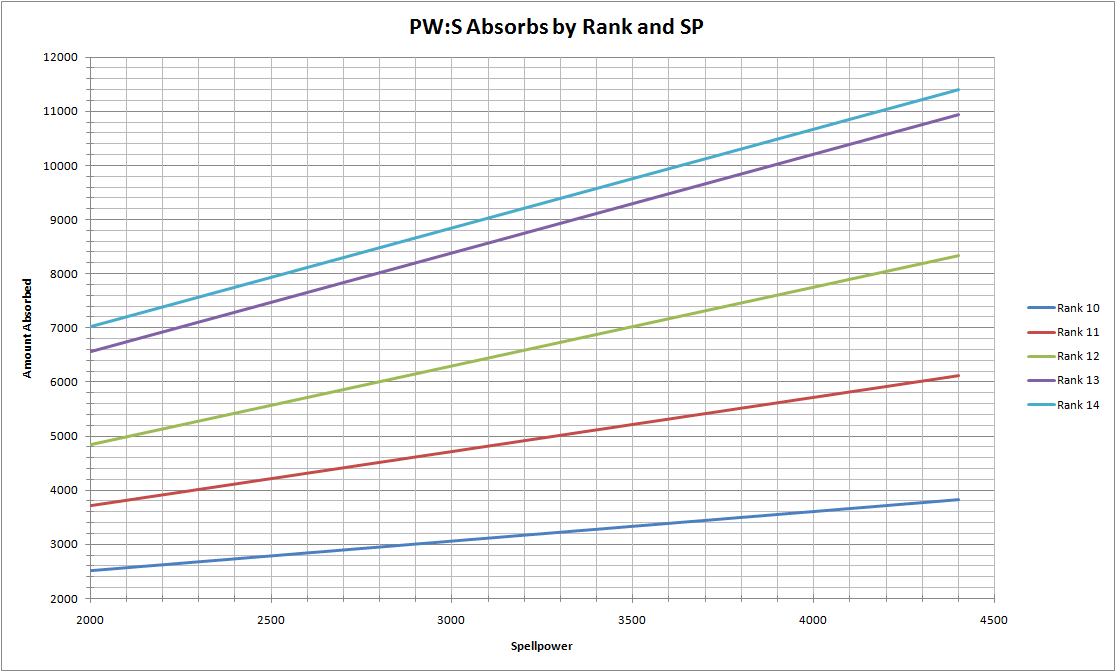
Read across to your typical raiding spellpower (as shown in your character sheet during a fight) and then read up to see how much each rank of shield will absorb
Then I went through raid logs to get some real data on absorbs. In the recent raid I used PW:S 12 as my primary rank, based on the PlusHeal suggestion. Here’s some WoL extracts: the first is with PW:S Rank 14, the second is with PW:S Rank 12. Note that when these logs were acquired the ICC buff was at 15%.
Results
I definitely made some gains using PW:S 12 over PW:S 14, and the mana situation improved subjectively, but the log shows that I could have gained yet more mana back.
In the first case I cast 18 shields at a cost of 11988 mana, and gained 3518 mana back.
In the second case I cast 20 shields at a cost of 13320 mana, and gained 7036 mana back (I have not included the extra Rapture proc from bubbling myself, in case you wonder about the maths. I think it’s better to compare without it).
Even in the better of the two cases I am only getting back around 53% of the mana I spent, and only 40% of the theoretical maximum of 17590 mana I could have got back from those 20 shields.
The problem is that my shields were too close in size to the size of the Infest hits for this trick to be totally effective. Both Infest and the shields varied in size between 7,000 and 8,000 so where Infest was low or the shield was high I didn’t get mana returns. The Ashen Verdict ring proc would easily be enough to rob me of an entire cycle’s Rapture returns.
Looking at the tables at the top, and given my current gear level of ilvl 264 across the board, plus the 277 reputation ring, I would conclude that I should drop further down to Power Word: Shield Rank 11 instead of Rank 12 to get better mana returns while still taking enough damage off the Infest to prevent it ticking on most people.
However, since I didn’t have mana issues with Rank 12, perhaps Rank 12 would be a suitable compromise between giving adequate mana returns and guaranteeing Infest won’t tick on people I’ve bubbled. It’s important to adapt your play to the rest of your raid, so if Infest is a problem for your raid it’s worth spending more mana on higher ranks.
Extra tip for VuhDo users
VuhDo, while being awesome in many regards, has a slight blind spot when it comes to spell ranks. Iza, the author, explains:
VuhDo is not using any spell ranks internally, which leaves it to wow client to choose the apropriate rank for the target’s level. Which should be 14 for rank 80 targets indeed.
Therefore if you want to use a lower rank of PW:S with VuhDo you’re going to need to use a macro instead, you can’t just type “Power Word: Shield(Rank 12)” into the box. So here’s a simple macro to use:
/cast [@mouseover] Power Word: Shield(Rank 11)
All you need to do is create the macro, being careful not to name it after the spell (also likely to confuse VuhDo) and then bind the macro to the keypress or mouseclick in VuhDo’s options.
Updates:
17th May – Added the chart, clarified the ICC and T10 bonuses being used, and tweaked some phrasing






